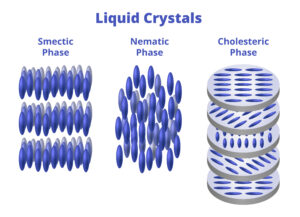2022.10.30
What is liquid crystal emulsification? Its Effects and Methods
In the past few years, we have often seen products made by liquid crystal emulsification in high-quality cosmetics. These products are said to have better moisturizing and penetration properties than cosmetics made by ordinary emulsification methods. In this column, we will discuss whether the liquid crystal emulsification method can produce functional formulations. What kind of cosmetics can it be used for and what kind of effects can be obtained? We will explain the following.
Definition and Principle of Liquid Crystal Emulsification
Liquid crystal emulsification is one of a number of emulsification methods. It is a technology to generate fine emulsion particles by dispersing oil in the liquid crystal phase formed by a surfactant by stirring. Incidentally, liquid crystal is a substance in an intermediate state between water and oil.

The advantages are that fine emulsified particles can be created even with weak stirring force and stable emulsions can be obtained. Furthermore, it is possible to add functions depending on the surfactant used.
Features of Liquid Crystal Emulsification
Liquid crystal emulsification has the following features.
Fine emulsion particles
When a surfactant is used to generate a liquid crystal phase and then agitated to disperse the oil phase, fine emulsion particles can be created. The emulsion particle diameter of general liquid crystal emulsions ranges from 1 to 15 μm, while that of liquid crystal emulsions is 0.1 to 1 μm. The fine emulsion particles enable the production of emulsions that are smooth and non-greasy to the touch.
Fragility of Emulsion Particles
The fine emulsion particles and the ability to stabilize water and oil with a small amount of emulsifier make the emulsion particles less fragile than those of conventional emulsions. This makes it possible to create emulsified formulations that not only reduce stickiness but also have high skin permeability.

Formation of liquid crystal structures such as lamellar structures
The oil phase is dispersed in the liquid crystal phase created by surfactants that easily form liquid crystal structures, forming lamellar and other liquid crystal structures. For example, the lamellar liquid crystal structure is the same structure as the cellular material between keratinocytes on the surface of the skin, and when used in cosmetics, it has higher skin penetration power than ordinary emulsified formulations and prevents the evaporation of skin moisture.
Types and Features of Liquid Crystal Emulsification Cosmetics
In general, cosmetics emulsified by the liquid crystal emulsification method often have a lamellar liquid crystal structure and are often sold as high-end cosmetics.
Lotion
Lotion contains not only vitamins, amino acids, and other ingredients necessary for the skin, but also ceramide, peptides, licorice, moss extract, and other active ingredients not possessed by humans, and allows them to penetrate into the horny layer while replenishing moisture to the skin.
Emulsions and creams
In addition to vitamins and amino acids, which are natural moisturizers for the skin, ceramide, squalane, and other moisturizing ingredients not possessed by humans are allowed to permeate the stratum corneum, preventing evaporation of moisture from the skin and keeping it oily.

The lamellar structure is the same as the intercellular lipid that fills the space between the horny cells of human skin, with layers of water and oil like mille-feuille, with water-soluble ingredients in the water layer and oil-soluble ingredients in the oil layer. They are stably dissolved in each other. This is because each ingredient takes its time to penetrate into the skin.
In the case of lotions and emulsions manufactured by normal emulsification, the structure of the particles that contain the active ingredients is different from that of the stratum corneum, so when they are applied to the skin, the structure is broken and the active ingredients cannot penetrate deep into the stratum corneum.
Types of liquid crystal emulsification
There are several types of liquid crystal emulsification methods, but here are some of the most common.
Liquid crystal emulsification using lamellar liquid crystal
This is a general method of liquid crystal emulsification. In the first step, an oil phase is added to the liquid crystal under agitation to produce a gel-like oil-in-liquid crystal emulsion in which the oil is retained in the liquid crystal. In the second process, an aqueous phase is added to the gel to generate an o/w emulsion.
In the first step, double-chain surfactants that form lamellar liquid crystals suitable for liquid crystal emulsification are often used.
Liquid crystal emulsification using reverse hexagonal liquid crystals
Reverse hexagonal liquid crystals are formed by using a surfactant with strong hydrophobicity. When an aqueous phase is added to a liquid crystal containing oil under conditions where the liquid crystal does not disappear even if some oil is present, a w/o type emulsion is generated. Since the aqueous phase of this emulsion is separated from the oil phase by a strong liquid crystal film, it can exist stably even in systems with high water content where the volume of the internal phase is large.
w/o emulsions using liquid crystal emulsification have a more refreshing and water-repellent feel than regular w/o emulsions, and are used as the base for UV creams and cream-like foundations.

How to develop cosmetics using liquid crystal emulsification
By using liquid crystal emulsification, it is possible to create cosmetics with a lamellar structure that has high permeability and can be sold at a high price point. However, although liquid crystal emulsification does not require high stirring power, it does require the development of specialized emulsifiers. In fact, there are not so many cosmetics with lamellar structure functionality using liquid crystal emulsification on the market.
The JC Dermatology Laboratory has examples of formulations of cosmetics with a lamellar liquid crystal structure, which can be used as a reference for the development of cosmetic formulations.
Example of formulations
>>Refreshing moisturizing cream

 contact
contact
